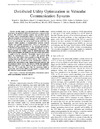Please use this identifier to cite or link to this item:
https://accedacris.ulpgc.es/jspui/handle/10553/75373
| DC Field | Value | Language |
|---|---|---|
| dc.contributor.author | Diaz-Ibarra, Miguel A. | en_US |
| dc.contributor.author | Campos-Delgado, Daniel U. | en_US |
| dc.contributor.author | Gutierrez, Carlos A. | en_US |
| dc.contributor.author | Luna-Rivera, Jose M. | en_US |
| dc.contributor.author | Cabrera Almeida, Francisco José | en_US |
| dc.date.accessioned | 2020-11-11T09:59:55Z | - |
| dc.date.available | 2020-11-11T09:59:55Z | - |
| dc.date.issued | 2020 | en_US |
| dc.identifier.issn | 0018-9545 | en_US |
| dc.identifier.other | Scopus | - |
| dc.identifier.uri | https://accedacris.ulpgc.es/handle/10553/75373 | - |
| dc.description.abstract | In this paper, we study the problem of utility maximization in the uplink of vehicle-to-infrastructure communication systems. The studied scenarios consider four practical aspects of mobile radio communication links: i) Interference between adjacent channels, ii) interference between roadside units along the way, iii) fast and slow channel fadings, and iv) Doppler shift effects. We present first the system model for the IEEE 802.11p standard, which considers a communication network between vehicles and roadside infrastructure. Next, we formulate the problem of utility maximization in the network, and propose a distributed optimization scheme. This distributed scheme is based on a two-loop feedback configuration, where an outer-loop establishes the optimal signal to interference-noise ratio (SINR) that maximizes the utility function per vehicle and defines a quality-of-service objective. Meanwhile, inner-control loops adjust the transmission power to achieve this optimal SINR reference in each vehicle node regardless of interference, time-varying channel profiles and network latency. The computation complexity of the distributed utility maximization scheme is analyzed for each feedback loop. Simulation results indicate that the proposed scheme reaches the objective SINRs that maximize utility and improve energy efficiency in the network with a low time cost. The results also show that the maximum utility is consistently achieved for different propagation scenarios inside the vehicular communication network. | en_US |
| dc.language | eng | en_US |
| dc.relation.ispartof | IEEE Transactions on Vehicular Technology | en_US |
| dc.source | IEEE Transactions on Vehicular Technology[ISSN 0018-9545],v. 69 (10), p. 11992-12003, (Octubre 2020) | en_US |
| dc.subject | 332505 Radiocomunicaciones | en_US |
| dc.subject.other | Vehicular communications | en_US |
| dc.subject.other | Feedback Control | en_US |
| dc.subject.other | Transmission Power | en_US |
| dc.subject.other | Utility Maximization | en_US |
| dc.title | Distributed Utility Optimization in Vehicular Communication Systems | en_US |
| dc.type | info:eu-repo/semantics/Article | en_US |
| dc.type | Article | en_US |
| dc.identifier.doi | 10.1109/TVT.2020.3008336 | en_US |
| dc.identifier.scopus | 85095691952 | - |
| dc.contributor.authorscopusid | 57189244581 | - |
| dc.contributor.authorscopusid | 57207809029 | - |
| dc.contributor.authorscopusid | 36892920600 | - |
| dc.contributor.authorscopusid | 8424610900 | - |
| dc.contributor.authorscopusid | 57219840102 | - |
| dc.identifier.eissn | 1939-9359 | - |
| dc.description.lastpage | 12003 | en_US |
| dc.identifier.issue | 10 | - |
| dc.description.firstpage | 11992 | en_US |
| dc.relation.volume | 69 | en_US |
| dc.investigacion | Ingeniería y Arquitectura | en_US |
| dc.type2 | Artículo | en_US |
| dc.utils.revision | Sí | en_US |
| dc.date.coverdate | Octubre 2020 | en_US |
| dc.identifier.ulpgc | Sí | en_US |
| dc.contributor.buulpgc | BU-TEL | en_US |
| dc.description.sjr | 1,365 | |
| dc.description.jcr | 5,978 | |
| dc.description.sjrq | Q1 | |
| dc.description.jcrq | Q1 | |
| dc.description.scie | SCIE | |
| item.fulltext | Con texto completo | - |
| item.grantfulltext | open | - |
| crisitem.author.dept | GIR IDeTIC: División de Ingeniería de Comunicaciones | - |
| crisitem.author.dept | IU para el Desarrollo Tecnológico y la Innovación en Comunicaciones (IDeTIC) | - |
| crisitem.author.dept | Departamento de Señales y Comunicaciones | - |
| crisitem.author.orcid | 0000-0003-1869-1164 | - |
| crisitem.author.parentorg | IU para el Desarrollo Tecnológico y la Innovación en Comunicaciones (IDeTIC) | - |
| crisitem.author.fullName | Cabrera Almeida, Francisco José | - |
| Appears in Collections: | Artículos | |
SCOPUSTM
Citations
1
checked on Jun 8, 2025
WEB OF SCIENCETM
Citations
1
checked on Jan 18, 2026
Page view(s)
72
checked on Jan 10, 2026
Download(s)
1
checked on Jan 10, 2026
Google ScholarTM
Check
Altmetric
Share
Export metadata
Items in accedaCRIS are protected by copyright, with all rights reserved, unless otherwise indicated.
